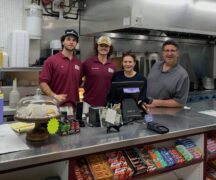By DAVID DUPONT
BG Independent News
There’s no place to hide it seems from mass shootings.
Bowling Green Sgt. Mike Bengela, a 28-year veteran, gave a presentation on how to survive an active shooter just days after a gunman killed 11 in the Tree of Life congregation in Pittsburgh and another gunman killed two people in a Kroger store in Jeffersontown, Kentucky. And earlier in the year, 17 died at Stoneman High School in Parkland Florida.
Since his talk, the nation was sent reeling again when a gunman killed 12 at a country-western bar in Thousand Oaks, California.
Praying, shopping, studying, line dancing — that’s what people were doing when they became targets of armed assailants.
Since Columbine in 1999, more that 350 people have died in such incidents.
Law Enforcement and safety official have not been standing still. The advice for both people under attack and for law enforcement has changed.
Bengela’s talk, sponsored by the Bowling Green Chamber of Commerce and UBS Financial Services, was based on the ALICE protocol — alert, lockdown, inform, counter and evacuate, or a simpler variation — run, hide and fight.
Bengela said at Columbine victims took shelter within the library, even though there was a door through which they could have exited. They hid under desks as they had been taught. That made them easy targets. The “kill rate” for “static targets” is “astronomical.”
If they had exited, he said they would have headed to a rallying spot. That location was known to the shooters — who he refused to name rather than to give them more notoriety.
They had rigged propane bombs in the trunks of their cars and parked them where they knew people fleeing the building would assemble. But because the watches they used had plastic parts, not metal, the bombs failed to detonate. Otherwise hundreds more would have died.
What these killers want, he said, was a high body count.
But, as a retired teacher attending noted, police tactics have also changed. At Columbine they waited outside until the SWAT team arrive. In such attacks, someone dies every 16 seconds. So now officers go in solo to try to stop the vicim. At the Thousand Oaks club shooting, a sheriff’s deputy died doing that.
Each instance has taught law enforcement something. The first option should not be to duck and cover, but to flee. If that’s not possible, do what you can to blockade yourself and others, and if possible resist, he said.
Bengela went through the shootings at Virginia Tech, looking at what happened in each room. Those they were passive died. In other rooms people jumped out windows. In one a professor, who was a Holocaust survivor, and one of his students, blocked the door of the room. They died in their efforts, but everyone else in the room lived.
“You are your own first responder in the situation,” Bengela said. “You have to buy time to save your life.”
First, he said, “if you can get out, get out.”
A person with a concealed carry permit may decide to handle the situation. “That may save lives.”
But if that person has family, including children, present, “that may that may not be go time.”
If someone enters a building, and someone with CCW has a weapon in his car. He should not fetch it and re-enter the situation. If he can get out, he should.
Bengela is not fan of arming teachers. Not all maybe suitable to carry a weapon, and more weapons on the scene can be confusing. Police may not know who’s the shooter.
“Keep yourself alive with whatever you have at hand,” he said. “Anything you have available is a weapon.” It may be a pen, a stapler, a laptop computer.
He advised those who are not familiar with guns to learn what it sounds like when a gunman is reloading. That’s a window of opportunity to either flee or attack.
Sometimes hiding and barricading inside is the only option. Bengela walked through the dining room in the Stone Ridge Golf Club, and pointing out all the factors that can make it easy or hard to stay secure.
Be aware and think outside the box, he said.
While hiding, “be prepared to stay for the duration.”
But even before these attacks occur, people need to be alert for “red flags.” Many of these attacks are perpetrated by someone the victims know.
If something seems strange they should report it. But often they fear that will make them a target, or they will be accused of stereotyping someone.
The Columbine shooters exhibited warning signs. They tested their bombs in the country. People knew about it, but no one said anything. “Boys will be boys,” Bengela said, and blow things up.
Asked to create a business plan, they created a business plan for a murder-for-hire operation.
They got an “A.”





